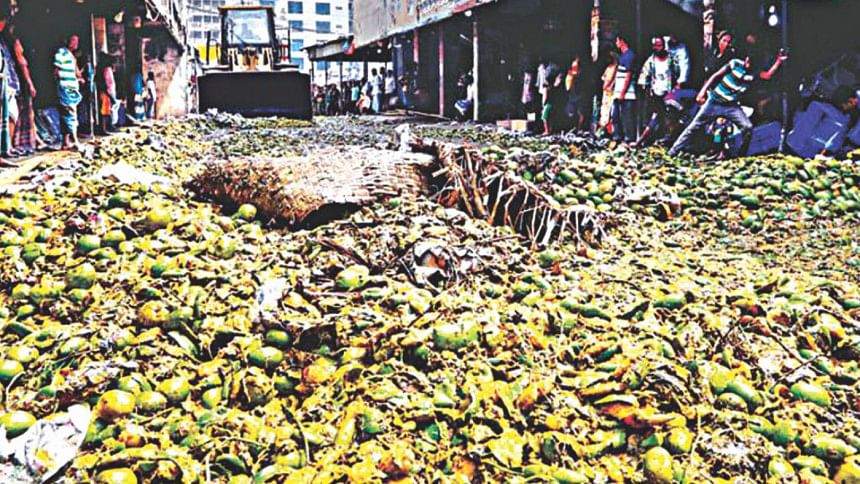The Forbidden Fruit?

Besides sending a strong message to shady traders, the picture of RAB destroying 40 tonnes of chemically ripened mangoes felt as if the fruit was on the verge of taking the baton of the "forbidden fruit" from the "infamous" apple. Mango lovers fervently hope that this batch would be a drop in the ocean and that the overwhelming proportion of the harvest would instead bring back the smile on our faces. For mangoes not only symbolise our summer but are so important to our lives that references to it are woven into our national anthem.
The sticky deliciousness of mangoes heralds a season of lazy summer afternoons. From many years back I remember my delight at the sight of the mango tree laden with the luscious Fazli aam in our backyard. My mother would be quick to rustle up paanchphoron, mustard oil and guur to make the sweet and sour variety and the crystal clear Kashmiri anchar. I knew jam and morobba from raw mangoes would follow as would aamchhur, aamshatto and more.
In the summer vacation, children usually have a time of their life at their grandparents' home on the suburban areas, exploring the trees laden with seasonal fruits. While the young boys have a time of their lives targeting the juicy fruits with slingshot or pieces of brick chips, the girls gather around them and collect and have them to their heart's content.
Mango is the leading seasonal cash crop of the northwestern region of Bangladesh and dominates the economy in Rajshahi and Chapainawabganj districts. Farmers are employed for different tasks on mango orchards such as nursing, harvesting and packing mangoes for transportation during the season every year. According to reports there are over 270 varieties of sweet mangoes in the Rajshahi region alone.
With the onset of the Bangla month of Jaishtha, commonly known as "Modhumash", juicy and delectable fruits like litchi, jam, kanthal (jackfruit), and mangoes have hit local markets. It is an age-old tradition that during the month of Baishakh-Jaishtha, different regions celebrate nature's succulent gift in many ways.
Mango production has also been on the rise. According to a report in The Daily Star, Bangladesh produced nearly 12 lakh tonnes of mangoes in 2016, an annual growth of about 15 percent. On basis of acreage allowed to its production, the rise is more dramatic—over a 50 percent growth to 94,000 acres since 2008. Whereas there were only 12 mango-producing districts in 2005, there are now 23. Md Sorof Uddin, senior scientific officer (horticulture) at horticulture research station of BARI in Chapainawabganj, estimates the market for mangoes to be worth over Tk 5,000 crore annually.
On the back of this growth, mangoes have become a part of the country's export basket. The mangoes grown in Satkhira such as the Himsagar, Lengra and Amrapali sit at Asda stores across the UK, a subsidiary of the American retail company Walmart. Cultivation techniques have also changed to cater to the export market. The bagging system for varieties such as Gopalbhog, Khirsapat, Lengra, Lakhna, Fazli, Ashina and Amrapali has become very popular. The fruits are covered with bags when a green mango is 35-40 days old to protect mangoes from pests and hail. It reduces the use of harmful chemical insecticides and pesticides, thus helping to retain the quality and colour of the mango. Entrepreneurs of Rajshahi are optimistic about the prospect of mango exports to England, Italy, France, Germany and other European countries after the introduction of the bagging technique.
With such popularity at home and abroad, it's only natural that we take pride in our mangoes. No wonder the premium varieties are Fazli, Lengra, Gopalbhog, Himsagar, Khirsapat, Ashhwina, Khisanbogh, Ranipachhand, Haribhanga, Laksmanbhog, Mohanbhog, Misribhog, etc. Fazli, Lengra, Gopalbhog and Khisrapat have exotic names to go with their mouthwatering taste.
But as the recent RAB drive shows, chemically treating the mangoes is spoiling its taste as well as its appeal. As part of a move against food poisoning, mobile courts destroy several maunds of mangoes that are sprayed with toxic chemicals every year to avoid public health crises. But a disturbing discovery in the recent RAB raid is the detection of a new chemical called ethephon hormone that may be even more damaging to our health than formalin—the chemical that was used previously. Many experts feel that while strict fines and punishments may be a deterrent, there could be a wider effort to enforce these all along the entire supply chain and not just at the point of sale.
Not content to leave it to law enforcement, consumers have undertaken some initiatives which have begun to gain traction. One such initiative that caught my attention was the development of privately owned tracts of mango orchards. In a recent TV interview, movie star Ferdous mentions the Green Dhaka project under which he was offered two five-katha plots in Thakurgaon—one for mango and one for litchis. The project is staffed by a private company responsible for the development and upkeep of the orchards, while its owners have been offered smaller plots to enjoy the fruits of labour—quite literally. Chemical-free fruits to enjoy with family and friends, it's an option that would appeal to many.
For the rest who remember days of old times when in-laws and relations alike enjoyed the magical fruit as intoxicating desserts, we ardently hope the strong long-term economics of trading in healthy produce prevails and that we continue to enjoy a fruit so intertwined in our lives.
Sadya Afreen Mallick is Chief, Culture Initiatives and former Editor, Arts and Entertainment, The Daily Star.





Comments